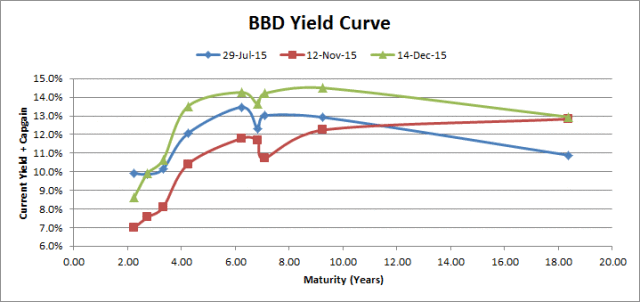There was an article on the Globe and Mail regarding my declaration that I had invested in Bombardier preferred shares (TSX: BBD.PR.B / BBD.PR.C).
I’m going to look very smart or very stupid at the end of this ordeal.
I will emphasize this is a high risk, very high reward-type opportunity. With high risk goes the chance for permanent capital loss, so the position size is appropriately small.
At current market prices, BBD.PR.B trades at a 12.6% yield, while BBD.PR.C trades at a 16.5% yield.
Other than the obvious business execution risk entailed within their aircraft division (specifically the execution of the C-Series project), there is another huge risk for investors: they will suspend preferred share dividends.
If this happens, BBD.PR.C will trade significantly lower (percentage-wise) than BBD.PR.B. The conversion risk is another component of the yield differential.
The comment about bond yields was accurate as of the middle of November, where after the government equity injections the short-term maturity bonds traded at reasonable yields. Today, however, yields have significantly widened, which also accounts for why the preferred shares are trading at such blowout yields.
Below is a graph of various yield to maturity curves of Bombardier debt (note these are NOT “yield to maturity” curves, I use a current yield + capital gain calculation which is non-standard but a more intuitive measurement for high yield debt I prefer using):
The near-term maturities have risen to the 10% yield levels, which puts the corporate entity in the refinancing danger zone.
Considering how much equity was injected into the company (US$2.5 billion) over the past few months, this is not exactly an enthusiastic market for debt, especially their March 2018 issue which matures in just 2.25 short years from now (albeit this specific issue’s last trade was 98 cents on the dollar – but go back another 6 months and that one traded at 90 cents!).
Part of this is likely because of year-end dumping for tax reasons, and the embarrassment factor of any fund managers that are holding onto this – they don’t want those shares to appear on their year-end financial statements to clients!
However, there is also a very deeply political component to my investment thesis. The Quebec investments are part 1 of the story. I’m waiting for part 2 to resolve itself (and this does not involve a federal government investment – if it happens, it will be icing on the cake).
